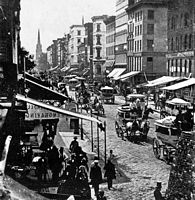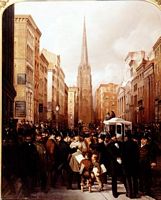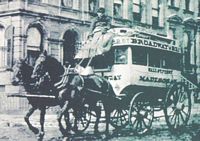Omnibuses
 Until Brower started his Broadway omnibus service in 1827,
the cities of the United States (and the world) lacked dependable
public transportation. Abortive attempts had been made. Blaise
Pascal, just before his death in 1662, tried to set up scheduled
service in Paris. Individual hackneys had been available in
London. But Brower apparently found the "tipping point" in the
year 1827. The world was ready. In Paris Stanislaus Baudry in
1828 revived Pascal's failed effort, and in London George
Shillibeer in 1829 began service similar to Brower's. The
need for such service led to its explosive growth. Photos and
stereopticon views show congestion in the streets of New York
City that rivals that of today. Other cities sought similar
service, and the demand for such vehicles was soon worldwide.
Until Brower started his Broadway omnibus service in 1827,
the cities of the United States (and the world) lacked dependable
public transportation. Abortive attempts had been made. Blaise
Pascal, just before his death in 1662, tried to set up scheduled
service in Paris. Individual hackneys had been available in
London. But Brower apparently found the "tipping point" in the
year 1827. The world was ready. In Paris Stanislaus Baudry in
1828 revived Pascal's failed effort, and in London George
Shillibeer in 1829 began service similar to Brower's. The
need for such service led to its explosive growth. Photos and
stereopticon views show congestion in the streets of New York
City that rivals that of today. Other cities sought similar
service, and the demand for such vehicles was soon worldwide.
 By 1856 Stephenson was producing 300 omnibuses a year. He shipped
vehicles to both coasts of the U. S., to Mexico and countries in
South America, to Europe, Russia, and Japan, and to Bombay, India.
The success of Stephenson's omnibuses presaged in the 19th century
the success in the 20th of Henry Ford's Model T's, but Stephenson's
colorfully decorated vehicles would have contrasted sharply with
Ford's uniformly black and undecorated ones.
By 1856 Stephenson was producing 300 omnibuses a year. He shipped
vehicles to both coasts of the U. S., to Mexico and countries in
South America, to Europe, Russia, and Japan, and to Bombay, India.
The success of Stephenson's omnibuses presaged in the 19th century
the success in the 20th of Henry Ford's Model T's, but Stephenson's
colorfully decorated vehicles would have contrasted sharply with
Ford's uniformly black and undecorated ones.
 Because the congestion was so bad, and because the muddy conditions
of many streets could make movement of the omnibus itself difficult,
the idea of putting the cars on rails became attractive. Horses
continued to provide the power. New York had its first horse car
line on rails in 1832. "By the 1880's there were some 525 horse
car lines in 300 American cities." (George W. Hilton, Transport
technology and the urban pattern," Journal of Contemporary
History Vol 4, no. 3 July 1969, 123-125.)
Because the congestion was so bad, and because the muddy conditions
of many streets could make movement of the omnibus itself difficult,
the idea of putting the cars on rails became attractive. Horses
continued to provide the power. New York had its first horse car
line on rails in 1832. "By the 1880's there were some 525 horse
car lines in 300 American cities." (George W. Hilton, Transport
technology and the urban pattern," Journal of Contemporary
History Vol 4, no. 3 July 1969, 123-125.)
 Stephenson's familiar omnibus continued to be an ever-present
part of the daily scene in cities of the U.S. and of many
foreign countries. The painting "Wall Street, Half Past Two
O'Clock, October 13, 1857," by James Cafferty (1819-1869) and
Charles G. Rosenberg (1818-1979), shows that it also remained
a significant part of the city of its birth. In the picture it
stands ready as usual, door open, waiting for the next passenger.
Stephenson's familiar omnibus continued to be an ever-present
part of the daily scene in cities of the U.S. and of many
foreign countries. The painting "Wall Street, Half Past Two
O'Clock, October 13, 1857," by James Cafferty (1819-1869) and
Charles G. Rosenberg (1818-1979), shows that it also remained
a significant part of the city of its birth. In the picture it
stands ready as usual, door open, waiting for the next passenger.
 Brower's Broadway service that had started the entire revolution
in public transportation continued to serve the public until June 21,
1885, when, according to Fred Dietz, 1913: A Leaf from the Past
(p. 59), his omnibuses were "superseded by Horse Cars" on rails.
John H. White, in his Horsecars, Cable Cars and Omnibuses
(p. xi) says that Stephenson's shop appears to have continued
limited omnibus production until the late 1890's" and that
"New York's horse-drawn buses ran as late as 1908." And the New
York Transit Museum's website (see Bibliography) informs us that
it was 1917 before "Manhattan's last horsecar line [on rails] stopped
running on Bleecker Street."
Brower's Broadway service that had started the entire revolution
in public transportation continued to serve the public until June 21,
1885, when, according to Fred Dietz, 1913: A Leaf from the Past
(p. 59), his omnibuses were "superseded by Horse Cars" on rails.
John H. White, in his Horsecars, Cable Cars and Omnibuses
(p. xi) says that Stephenson's shop appears to have continued
limited omnibus production until the late 1890's" and that
"New York's horse-drawn buses ran as late as 1908." And the New
York Transit Museum's website (see Bibliography) informs us that
it was 1917 before "Manhattan's last horsecar line [on rails] stopped
running on Bleecker Street."
 By the first years of the new century downtown streets of urban
America were a jumble of vehicles. In this image of Boston's
Post Office Square in 1904 I cannot find that any motorized
vehicle has yet joined the confusion (see Bibliography).
By the first years of the new century downtown streets of urban
America were a jumble of vehicles. In this image of Boston's
Post Office Square in 1904 I cannot find that any motorized
vehicle has yet joined the confusion (see Bibliography).

